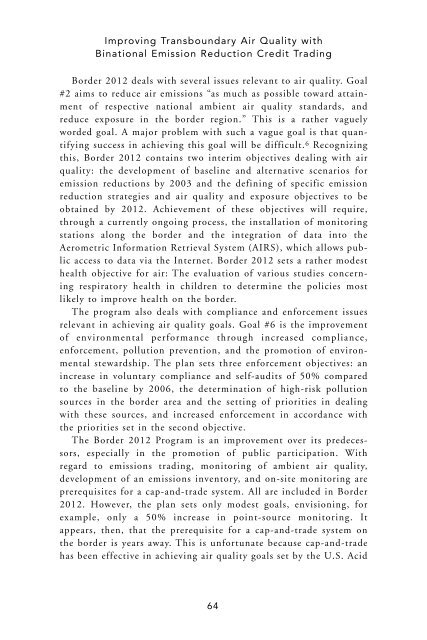Entire Book - Southwest Consortium for Environmental Research ...
Entire Book - Southwest Consortium for Environmental Research ...
Entire Book - Southwest Consortium for Environmental Research ...
You also want an ePaper? Increase the reach of your titles
YUMPU automatically turns print PDFs into web optimized ePapers that Google loves.
Improving Transboundary Air Quality with<br />
Binational Emission Reduction Credit Trading<br />
Border 2012 deals with several issues relevant to air quality. Goal<br />
#2 aims to reduce air emissions “as much as possible toward attainment<br />
of respective national ambient air quality standards, and<br />
reduce exposure in the border region.” This is a rather vaguely<br />
worded goal. A major problem with such a vague goal is that quantifying<br />
success in achieving this goal will be difficult. 6 Recognizing<br />
this, Border 2012 contains two interim objectives dealing with air<br />
quality: the development of baseline and alternative scenarios <strong>for</strong><br />
emission reductions by 2003 and the defining of specific emission<br />
reduction strategies and air quality and exposure objectives to be<br />
obtained by 2012. Achievement of these objectives will require,<br />
through a currently ongoing process, the installation of monitoring<br />
stations along the border and the integration of data into the<br />
Aerometric In<strong>for</strong>mation Retrieval System (AIRS), which allows public<br />
access to data via the Internet. Border 2012 sets a rather modest<br />
health objective <strong>for</strong> air: The evaluation of various studies concerning<br />
respiratory health in children to determine the policies most<br />
likely to improve health on the border.<br />
The program also deals with compliance and en<strong>for</strong>cement issues<br />
relevant in achieving air quality goals. Goal #6 is the improvement<br />
of environmental per<strong>for</strong>mance through increased compliance,<br />
en<strong>for</strong>cement, pollution prevention, and the promotion of environmental<br />
stewardship. The plan sets three en<strong>for</strong>cement objectives: an<br />
increase in voluntary compliance and self-audits of 50% compared<br />
to the baseline by 2006, the determination of high-risk pollution<br />
sources in the border area and the setting of priorities in dealing<br />
with these sources, and increased en<strong>for</strong>cement in accordance with<br />
the priorities set in the second objective.<br />
The Border 2012 Program is an improvement over its predecessors,<br />
especially in the promotion of public participation. With<br />
regard to emissions trading, monitoring of ambient air quality,<br />
development of an emissions inventory, and on-site monitoring are<br />
prerequisites <strong>for</strong> a cap-and-trade system. All are included in Border<br />
2012. However, the plan sets only modest goals, envisioning, <strong>for</strong><br />
example, only a 50% increase in point-source monitoring. It<br />
appears, then, that the prerequisite <strong>for</strong> a cap-and-trade system on<br />
the border is years away. This is un<strong>for</strong>tunate because cap-and-trade<br />
has been effective in achieving air quality goals set by the U.S. Acid<br />
64









